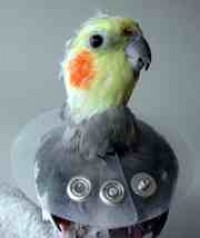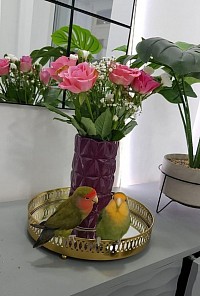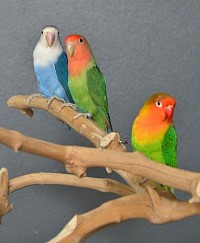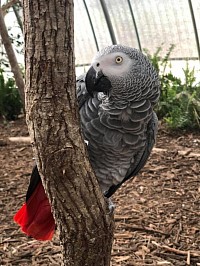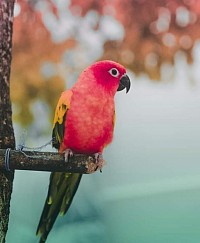Behavioural Problems in Parrots!
Feather Plucking!
There can be many reasons why a bird plucks his/her feathers. Some common causes are:
Page Under Construction!
Biting Problems!
When a bird bites you ignore it. Never shout out or push it away from you, the bird will see this as playing and will do it even more.
With young birds, there is often a "teething stage" encountered where the youngsters will "beak" almost everything it comes in contact with. A bird's beak is filled with encapsulated nerve endings, and is used to experience sensation, texture, taste, resilience of objects, etc. In these instances, the "beaking" cannot be considered as biting but as experimentation. "Beaking" of human fingers, which may lead to biting later, can be gently discouraged by redirecting the bird to an appropriate toy or other approved chewable item.
With older birds, biting is obviously the most definitive form of showing displeasure. Biting birds do so for a reason.
The bird may be feeling threatened, frightened or startled. Birds will bite during display; to protect their nest; or when the owner is doing something the bird disproves of.
Birds may also bite their mate or beloved human in an attempt to
protect them. A bird's instinct is to flee when faced with an intruder, and in an attempt to encourage his "mate" to flee, it may bite at the owner as a way of encouraging this.
Biting can also be caused by displaced aggression; when unable to bite the desired object, your bird will bite the closest thing at hand. When encouraging a bird to step up onto your hand, do not misunderstand an open beak aimed at your hand as an attempt to bite. Birds almost always "test" a perch before stepping onto it to ensure its stability, and will touch his beak to your hand before stepping onto it.
Q. My Cockatiel bites me when I put him back in his cage, what can I do to stop the biting?
A. If your Cockatiel only bites when he is being put back in the cage have you considered using a perch to put him back in when it's time?
When you do this, make sure you have a favourite treat to give him as soon as he gets back inside. Whistle and tell him what a "good boy" he is when he goes back in. Is he on a pelleted diet? If so, a piece of millet spray will be a very welcomed treat for good behaviour going into the cage.
If he is currently on a seed based diet please read the articles on our parrot nutrition page to get ideas on changing his diet to a healthier one. One of the many benefits of the pelleted diet is that birds can be rewarded with seeds and it is a true reward since they aren't used to getting them on a daily basis.
Don't rush any diet changes, though, and remember diet changes must happen gradually and carefully (birds can and will starve them selves if they don't like the food they are offered). You must take one thing at a time. If you decide to change his diet, you will have to probably hold off on the major training until you make some headway on the diet change.
If your bird is on a seed based diet and you wish to work with the behaviour change before working on the diet, try to find something he really likes (millet, popcorn, cereal, Nutriberries, wheat bread) and use that as a reward every time he goes back into the cage. If you can make "going home" a pleasant trip for him, he will be less likely to be grouchy when put back.
Once you notice that he is becoming more pleasant about going home, you can gradually start putting him back with your hands rather than using the perch. Also, if he likes mirrors, you could try putting him back while holding a small mirror in front of him to keep him distracted.
Let him have the mirror for the first few minutes inside the cage and then remove it (if you find it makes him unsocial or aggressive which happens a lot when birds have unlimited access to mirrors in their cage).
If the bird bites you while he is on your hand, you can try the "earthquake" technique. What this means is that you gently jerk your hand (not enough to knock the bird off) so that the bird loses his balance immediately at the time you feel the bite.
This, hopefully, will cause the bird to associate the losing balance feeling (which they don't like) with the biting and, over time, cause him to stop biting.
Another thing you can try is to gently blow in the bird's face
when he bites. They generally don't like this and, again, it must be done immediately at the time of the bite for the bird to associate it with the biting action.
These things can work but must be done quickly and over a period of time.
Never, ever hit a bird or even gently tap at him since this will cause him to become even more afraid of hands.
Also, never use water to spray a misbehaving bird. Water should be an enjoyable experience and bathing is something we want to encourage birds to do. The bottom line is to try to make going home a pleasant experience.
Screaming Problems!
Some noise is natural
Screaming can be a problem in parrots and other pet birds are noisy animals. When communicating to their flock, they need to be loud in order to be heard.
Some species will celebrate the sunrise and sunset with squawking or singing; pet birds do the same.
Other species, whether in the wild or as part of a human family, will make window-shattering sounds throughout the day or vocalise several times a day for 20 minutes at a time.
Wild birds use vocalisation to warn others in the group about impending danger, such as a predator in the area. If a pet bird is afraid, she will do the same thing.
Birds who find themselves away from the flock call to the group and find their way back when the group answers. Your parrot may produce short sounds with pauses in between, and is simply saying, "Are you there?"
Such means of localising to communicate are normal. It is not normal, however, for a parrot to scream in the same pattern for lengthy periods of time. This is not a happy bird and she does not have a happy family.
Causes of excessive screaming
Screaming by unhappy birds can usually be traced back to an underlying problem that is stressing the bird. These stresses include:
Illness, including nutritional problems from a poor diet, which may cause the bird to change the amount of vocalisation or other behaviour. Rule out a possible illness by having your bird examined by a veterinarian.
A change in the family makeup, such as a new family member or the loss of a family member (e.g., death, gone away to college).
Loneliness or boredom, which often occurs if there is a change of routine (e.g., vacations, longer work day, holiday bustle).
A change in the environment, such as a move to a new home.
Fear, which can cause a bird to scream just as she would in the wild.
Jealousy, resulting from the addition of another pet or paying more attention to certain individuals in the house.
Inadequate sleep due to cage location, household noise (e.g., TV), too much light, or people moving around the house.
Reducing excessive screaming
Remember that some screaming is normal behaviour for a parrot. Your goal should NOT be to eliminate all screaming and loud squawking, but to reduce the screaming to a tolerable level. This will require gentle patience and consistency among all family members.
Start to rehabilitate the parrot by making sure her basic needs are being met, reestablish the humans as higher ranking (e.g., step-ups and step-downs), and keep a diary of all screaming episodes. In the diary, record all the information about the episode including but not limited to time of day, day of the week, phase of the moon, what is happening at the time, and the moods of the people and the bird before, during, and after the episode. With this information, hopefully, the cause of the screaming can be identified and eliminated.
The two questions which must be considered when trying to rehabilitate the parrot are "What should I do when the bird screams?" and "What should I do when the bird is behaving properly?"
When the bird is misbehaving, you do not want to inadvertently reinforce the behaviour, for this can make the behaviour problem worse. From the parrot's perspective, getting any attention while she is screaming may be a reward. Some parrots may actually like you to yell back since they love drama and the yelling becomes a reward. Yelling, hitting the bird or the cage, leaving the bird isolated, spraying her with water, or withholding food will only increase the stress on the bird and either make the screaming worse, or the bird will turn to another unacceptable behaviour such as feather picking.
Always reward a pet bird for not screaming the best way to improve the bird's behaviour is to give positive reinforcement, i.e., giving something good to the bird when she behaves correctly (e.g., sitting quietly on a perch). This could be a special toy, a food treat, and verbal praise. These are rewards. Do NOT use them to bribe the bird into better behaviour.
If a bird is exhibiting a bad behaviour in a certain circumstance, it is important to determine what it is you want the bird to do instead. Then you can teach the bird to substitute the desired behaviour for the undesired one. For instance, teach the bird to talk instead of scream. Then reward the desired talking behaviour. Consistency is absolutely necessary; reward the good and desired behaviour and do NOT reward, in any way, bad behaviour.
Some bird experts suggest that if the bird continues to scream, give the bird a dirty look, cover the cage, or leave the room, returning when the parrot exhibits an acceptable behaviour. Others suggest that this may actually worsen the problem, especially with birds who are screaming out of fear. This is why understanding why the bird is screaming is important. You can adjust your actions depending on the circumstances.
If the bird is screaming due to loneliness, you may need to think of other solutions. If the bird has a reason to be lonely because the owners can not give her sufficient attention, it may be helpful to get another bird for companionship. The new bird does not necessarily have to be a mate, and could even be kept in a separate cage. Think first, though. If you, the owner, do not have time for one bird, are you going to have time for two? Is it fair to the birds? You may want to seriously consider finding a new home for your bird until your life style changes and is better suited towards having a pet.
Foraging toys can prevent screaming in pet birds for many birds, an alternative outlet for the bird's energy needs to be provided. Exercise on play gyms, flapping sessions in the shower, supervising the bird while you take him outside, or leaving the television or radio on can all help relieve pent-up energy. Do not turn on nature shows on the television, though, as they may scare the bird into thinking a predator is in the room. Old phone books, natural, non-toxic tree branches with leaves, and paper cups can be given to the parrot to play with (and destroy). Use foraging toys to hide his food, so he has to work to get it. This gives much-needed mental stimulation, and provides a way of feeding that more closely resembles what the bird would do in the wild.
Prevention
Short daily training sessions should begin ideally from the first day the bird is brought home. Parrots respond to facial expressions and verbal praise. This type of positive reinforcement should be used when an appropriate response is given by the bird and no response should be given for incorrect responses. No aggression or punishment is involved in the training. The daily lessons need to continue until the bird responds willingly to the commands. Once the commands are followed, discontinue the training but continue to use the commands during the daily handling of the bird.
Remember, parrots use vocalisations as warnings and as ways to find the rest of the flock when separated from it. Screaming can often be prevented from starting by simply answering the parrot when she calls to you, and letting the bird know when you are leaving and have returned.
Conclusion
The screaming behaviour of parrots can often be resolved or minimised. This may take time and help from an experienced avian behaviourist, but if it allows the bird to stay in the house, it is worth it.
References and Further Reading
Gallerstein, G. The Complete Bird Owner's Handbook. Howell Book House. New York, NY; 1994.
Spadafori, G; Speer, B. Birds for Dummies. EDG Books Worldwide. Foster City, CA; 1999.
Wilson, L. Proceedings of the Western Veterinary Conference; 2001.
Parrot Rehabilitation!
NYPR believes in the philosophy that most behavior problems in parrots are human-created. When parrots are relinquished to us with behavior problems, often those problems disappear when handled by someone who doesn't reinforce those bad behaviors.
Many of the birds that come into rescue have behavioral issues that are typically either the result of uncorrected habits or owner mishandling. NYPR works to rehabilitate birds with behavioral issues that come to our rescue.
Our goal in making these birds good companions in people's homes is to work to eliminate those behavioral problems that could prevent them from finding permanent placement.
We offer support and training to our foster homes and to potential adopters as to how to deal with individual behavior problems and try to answer questions and offer support to the general bird-owning public to facilitate birds staying in their original homes as opposed to entering our rescue. You can read more about this here..
We help birds that have suffered from poor diet, an unstimulated environment, inadequate caging, perching and toys or any situation that could contribute to behavior issues.
Here are the ways you can obtain help with the behavior issue with your bird:
1) Contact us with your questions. No charge for this service.
3) Ask NYPR for other groups you can join, classes you can take and literature you can read to help find behavioural problem solutions.
3) See our pages for classes and seminars that may be of interest to you or contact us for more information.
4) Read our pages on Parrot behaviour, Parrot training, Feather plucking, Biting problems, and Screaming...
